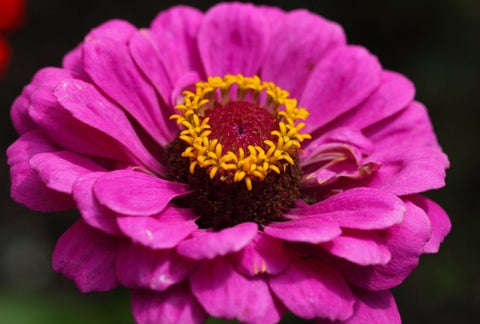Did you know that there was a time when zinnias were considered small and ugly? When the Spanish first saw the flower in Mexico, they named it “mal de ojos” or sickness of the eye. Since then, breeders have worked to develop many beautiful varieties.

Timing
Sprouts in 1-2 weeks. Harvest from Month 3+ on.

Full sun
Equivalent of 6+ hours of direct sun [DLI of 18+ mol/m²/day].

Care
Beginner friendly. You’ll sprout, thin, and deadhead.
nex
Can You Grow Zinnias Indoors: Best Zinnia varieties to grow inside.
Can you really grow zinnias indoors? Yes, you can. In fact, you can grow more than 1 variety indoors. We recommend choosing the dwarf zinnia varieties to grow indoors. Here is a list of our top 4 zinnias:
Dreamland Mix
Can be outstanding in beds, borders, and containers, and produce the perfect cut flowers. Flowers are good for cutting, drying and preserving.
AmazonZahara Starlight Rose
Brightens any space with their beautiful white and rose flowers. Stunning and edible. Used as a garnish in salads and summer soups.
Urban LeafStar Starbright
The perfect zinnia variety for annual beds that are in need of a ground cover. Can also be used for a beautiful edging or an unusual container piece.
AmazonThumbelina Mix
Awesome for small spaces, containers or border gardens. Attracts pollinators such as butterflies, bumblebees, and honeybees.
Amazon
Best Setup for Growing Zinnia Plants Indoors
If you’re starting zinnias indoors, you’ll be needing:
Growing Zinnias in Pots/Planter, you’ll need a:
Ceramic Self Watering Planter (preferred) or pot that is at least 4″ / 1 pint.
Soil Needed for Growing Zinnias Indoors:
Standard Potting Mix
Plant Food for Growing Zinnias Indoors:
Balanced Blend. This should be equal parts nitrogen, phosphorus, and potassium (with NPK numbers like 10-10-10).
Grow Light for Growing Zinnias Indoors:
A strong grow light that can give the equivalent of 6+ hours of direct sun [DLI of 18+ mol/m²/day].
Jump to: Our product recommendations
Preparing your Planter & Watering Zinnia Plants
Zinnia plants do well in moist soil conditions. If the soil dries out completely the roots will die back and it will be tough for the plant to recover. On the other hand, if the roots are exposed to standing water for too long, they can rot.
A Ceramic Self Watering Planter filled with a standard potting mix self-regulates to keep the soil at consistent moisture for your plant to thrive (and no watering guesswork for you).
To set one up:

- Fill up the planter with dry soil from the bag, gently tamping down the top.
- Dump the soil into a large mixing bowl and add water until the soil is moist, but not sopping wet (about ½ Cup)
- Mix in 1 tablespoon of the Balanced Blend Plant Food.
If you are using a regular pot instead, it should be a little bit bigger (at least 4″ / 1 pint and will need drainage holes to prevent it from being over watered. Let the top of the soil dry out between watering.
Starting your Zinnia Indoors: Seed vs Cutting vs Nursery Plant
New Zinnia plants can be started from seed, propagated from an established plant, or purchased live at many garden centers. We prefer to sprout from seed or propagate from a stem cutting, as it results in plants that are adapted to your growing conditions and limit the chances that you accidentally bring home pests.)
How to Plant Zinnia seeds

Zinnia grows quickly from seed. Plant 1 site in a 4″ / 1-pint container. In larger containers, space sites 4″ apart. For each site plant 2 seeds 1/4 inches deep. Keep the soil warm ( 70-90°F, ideally 80°F). Sprouts typically appear in 5 days but can be as quick as 3 days or as long as 7 days depending on your conditions.
Propagating Zinnia: How to Clone from a Stem Cutting

If you’ve already got a Zinnia plant you love (or a friend does!) you can easily “clone” it with just sharp scissors and a clean glass of water. First, cut a couple 6” shoots of new growth (avoid anything woody). Next, remove the lower leaves, so the bottom half is just stem. Place in a glass of 3” of water, making sure the cut leaf spots are underwater. Place the glass on a bright windowsill and change the water every few days. In a couple of weeks, roots should emerge and you can transplant them into your container. While using additional rooting hormones won’t hurt, it’s not necessary with Zinnia plants.
- Cut 6” section of new growth
- Remove leaves halfway and place them in the water on a sunny window sill
- Wait 14 days for a few ½ inch roots to form and carefully transplant into it final container
How to Transplant Zinnia

Live starter plants give you a big jump start on your first harvest. When you’re in a garden center – pick the bushiest plant available (tall and lanky ones will be weak growers) and give it a good inspection for pests. Leaves should be dark green without holes, spots, or curled edges. A best practice is to actually “quarantine” your plant for about a week after bringing it home to make sure it’s free and clear of ride-on pests.
Ensuring it’s pest and disease-free it’s time to transplant your seedling into its final home.
- Remove some soil from its final planter – leaving enough space for the bottom of the seedling to be just higher than the soil surface.
- Hold on to the base of the stem with one hand, and turn the pot over while gently pulling the seedling. Giving the pot a few squeezes can help dislodge it.
- Place in its final container and fill around it with soil so that it’s tight, but not compacted.
Where to grow your Zinnia plants
While you should take advantage of the sun (it’s free and perfect for plants) there are limited circumstances where indoor natural light is enough for Zinnia plants to grow well. A very bright window can cut your grow light needs in half, but if you want to grow lots of Zinnia, you’ll still need one. For an introduction to grow lights, head over to our post on grow lights for indoor gardeners. We’ve also got a buying guide for screw in types, but to keep things simple in this guide, we’ll just provide directions for the 24W Screw in Bulb by Sansi, which we think is a good middle-of-the-road option.

How bright should your grow light be?
Zinnia plants need the equivalent of 6+ hours of direct sunlight [DLI of 18+ mol/m²/day] to grow their best. In order to provide an equivalent amount with a grow light, it needs to be pretty bright! The 24W Sansi bulb should be placed 6 inches away from the top of the plant. This will give your PPFD (the standard measure of brightness) of 500 μmol/m²/s.
How many hours per day do your Zinnia plants need under a grow light?
Zinnia plants are known as “short-day,” meaning they’ll develop faster if they sense over 12 hours of darkness. We want them to progress into flowering as soon as possible, so we recommend setting up a timer to leave it on for only 10 hours per day.
How to Plant Zinnias Indoors: Zinnia Plants Grow Faster in Warmer Temps
Zinnia plants are called “warm-weather crops” and will speed up their metabolism when temperatures are warmer. On the other hand, if things get too hot they’ll wilt and become prone to disease. Ideal temperatures are around 75°F but anything between 60 and 90°F grows well.
Taking Care of Zinnias Week 1-2: Check for Sprouts
You could see seedlings in as little as 3 days (though 5 days is more typical). If it’s been 7 days and you still don’t have any sprouts, it’s likely that your setup is too cold.
Taking Care of Zinnias Week 3: Thin Your Seedlings

Thin your planter to only have 1 seedling per site – leaving the largest plant. If you are using the recommended planter (at least 4″ / 1 pint) this will mean you’ve got 1 plant after thinning. By getting rid of the smaller seedlings, you’re allowing the biggest and strongest one to flourish by reducing its competition for water, food, and space.
If your seedlings are under 1 inch, stretching out, or folding over, it’s likely that they don’t have quite enough light.
Taking Care of Zinnias Month 3+: How to Harvest Zinnia
Pick flowers right as they open to encourage more flowers to grow. If you let flowers go to seed on the plant it will start to end their life cycle so you should “deadhead” (remove the old flowers) to prolong the flowering season. If you fall behind, you can cut the plant by one-third which produces a second flush of leaves and flowers.
Taking Care of Zinnias Year 1: End of Life
You can prolong your zinnia’s life by pruning it and removing flowers before they have a chance to go to seed, but eventually, it will die. At this time is best to clear the plant and start over.
Shop This Blog so You can Start with Your Journey of Growing Zinnia Indoors
The right supplies can take the guesswork out of caring for your plants – and turn care from a daily to weekly routine. Through our grow tests, we’ve found these products to produce the best indoor Zinnia (and also have simple maintenance). Plants are adaptable and can grow in many different conditions, so they are by no means necessary if you already have other supplies.
Best Containers for Zinnia: Ceramic Self Watering Planters
Plants thrive on consistent moisture but can suffer if they’re waterlogged. A semi-porous ceramic self regulates ideal conditions. Our favorite is the COSWIP planter. Runner up is XS Self Watering Planter by Wet Pot.
Best Soil for Zinnia: Standard Potting Mix
Zinnia likes a rich and moist root zone – so you are best off with a standard potting mix – we like this Organic Mix by Espoma.
Best Nutrients for Zinnia: Balanced Blend
Zinnia likes nutrients that are equal parts nitrogen, phosphorus, and potassium (with NPK numbers like 10-10-10). For a Balanced Blend we recommend: Dr Earth All Purpose
Best Light for Zinnia: DIY or Soltech
There is a very small chance that you have the bright windows needed to grow these without a grow light. If you are looking for a higher-end option – we love the Aspect Light by Soltech. For a more affordable option, a DIY setup using a 24W Screw-in Bulb by Sansi with a Clamp Light and Mechanical Timer works well too. Check out our complete guide on a DIY setup for less than $40 or our buying guide for screw in bulbs.










There are no comments for this article. Be the first one to leave a message!